Effects of Zn Doping on Optical Properties of Polycrystalline β-Ga2O3
Abstract
1. Introduction
2. Results and Discussion
2.1. The Effect of Zn Doping on the CRYSTAL Structure and Surface Morphology of β-Ga2O3
2.2. The Influence of Zn Doping on the Phonon Vibrations of β-Ga2O3
2.3. The Impact of Zn Doping on the Fundamental Optical Properties of β-Ga2O3
2.4. The Influence of Zn Doping on the Photoluminescence Properties of β-Ga2O3
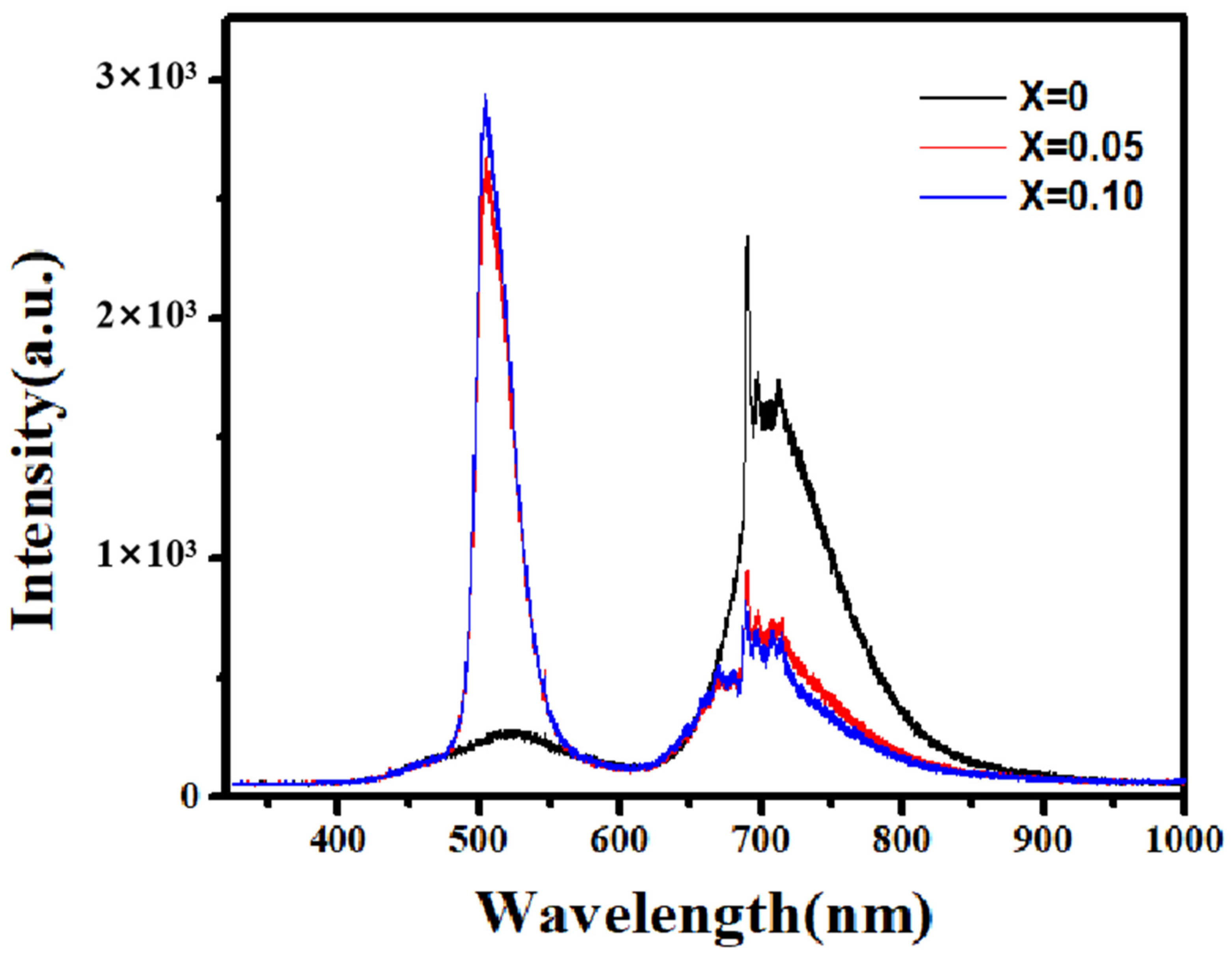
3. Materials and Methods
4. Conclusions
Author Contributions
Funding
Institutional Review Board Statement
Informed Consent Statement
Data Availability Statement
Conflicts of Interest
Abbreviations
| Vo/VGa | Vacancy of Oxygen/Gallium |
| PL | Photoluminescence |
| MOCVD | Metal-organic Chemical Vapor Deposition |
| XRD | X-Ray Diffraction |
| SEM | Scan Electron Microscope |
| SE | Spectroscopic Ellipsometry |
| CP | Critical Points |
| CBM | Conduction Band Minimum |
| VBM | Valence Band Maximum |
| UV | Ultra-violet |
References
- Roy, R.; Hill, V.G.; Osborn, E.F. Polymorphism of Ga2O3 and the System Ga2O3-H2O. J. Am. Chem. Soc. 1952, 74, 719–722. [Google Scholar]
- Playford, H.Y.; Hannon, A.C.; Barney, E.R.; Walton, R.I. Structures of Uncharacterised Polymorphs of Gallium Oxide from Total Neutron Diffraction. Chem. A Eur. J. 2013, 19, 2803–2813. [Google Scholar]
- Yoshioka, S.; Hayashi, H.; Kuwabara, A.; Oba, F.; Matsunaga, K.; Tanaka, I. Structures and energetics of Ga2O3 polymorphs. J. Phys. Condens. Matter 2007, 19, 346211. [Google Scholar]
- Guo, D.Y.; Li, P.G.; Chen, Z.W.; Wu, Z.P.; Tang, W.H. Research Progress on Ultra-Wide Bandgap Semiconductor β-Ga2O3, Deep Ultraviolet Transparent Electrodes, and Solar-Blind Detectors. Acta Phys. Sin. 2019, 68, 7–42. [Google Scholar] [CrossRef]
- Higashiwaki, M.; Sasaki, K.; Murakami, H.; Kumagai, Y.; Koukitu, A.; Kuramata, A.; Masui, T.; Yamakoshi, S. Recent progress in Ga2O3 power devices. Semicond. Sci. Technol. 2016, 31, 034001. [Google Scholar] [CrossRef]
- Liu, Z.; Yamazaki, T.; Shen, Y.; Kikuta, T.; Nakatani, N.; Li, Y. O2 and CO sensing of Ga2O3 multiple nanowire gas sensors. Sens. Actuators B Chem. 2008, 129, 666–670. [Google Scholar]
- Ji, Z.; Du, J.; Fan, J.; Wang, W. Gallium oxide films for filter and solar-blind UV detector. Opt. Mater. 2006, 28, 415–417. [Google Scholar]
- Yu, F.-P.; Ou, S.-L.; Wuu, D.-S. Pulsed laser deposition of gallium oxide films for high performance solar-blind photodetectors. Opt. Mater. Express 2015, 5, 1240–1249. [Google Scholar]
- Li, Z.; Xu, Y.; Zhang, J.; Cheng, Y.; Chen, D.; Feng, Q.; Xu, S.; Zhang, Y.; Zhang, J.; Hao, Y.; et al. Flexible Solar-Blind Ga2O3 Ultraviolet Photodetectors with High Responsivity and Photo-to-Dark Current Ratio. IEEE Photonics J. 2019, 11, 1–9. [Google Scholar]
- Wang, H.; Zhou, Q.; Liang, S.; Wen, R. Fabrication and Characterization of AlGaN-Based UV LEDs with a ITO/Ga2O3/Ag/Ga2O3 Transparent Conductive Electrode. Nanomaterials 2019, 9, 66. [Google Scholar] [CrossRef]
- Minami, T.; Nishi, Y.; Miyata, T. Effect of the thin Ga2O3 layer in n+-ZnO/n-Ga2O3/p-Cu2O heterojunction solar cells. Thin Solid Films 2013, 549, 65–69. [Google Scholar] [CrossRef]
- Du, X.; Li, Z.; Luan, C.; Wang, W.; Wang, M.; Feng, X.; Xiao, H.; Ma, J. Preparation and characterization of Sn-doped beta-Ga2O3 homoepitaxial films by MOCVD. J. Mater. Sci. 2015, 50, 3252–3257. [Google Scholar] [CrossRef]
- Leedy, K.D.; Chabak, K.D.; Vasilyev, V.; Look, D.C.; Boeckl, J.J.; Brown, J.L.; Tetlak, S.E.; Green, A.J.; Moser, N.A.; Crespo, A.; et al. Highly conductive homoepitaxial Si-doped Ga2O3 films on (010) β-Ga2O3 by pulsed laser deposition. Appl. Phys. Lett. 2017, 111, 012103. [Google Scholar]
- Zhang, F.B.; Saito, K.; Tanaka, T.; Nishio, M.; Guo, Q.X. Electrical properties of Si doped Ga2O3 films grown by pulsed laser deposition. J. Mater. Sci. Mater. Electron. 2015, 26, 9624–9629. [Google Scholar] [CrossRef]
- Feng, Z.; Bhuiyan, A.F.M.; Kalarickal, N.K.; Rajan, S.; Zhao, H. Mg acceptor doping in MOCVD(010) β-Ga2O3. Appl. Phys. Lett. 2020, 117, 222106. [Google Scholar]
- Pearton, S.J.; Yang, J.; Cary, P.H.; Ren, F.; Kim, J.; Tadjer, M.J.; Mastro, M.A. A review of Ga2O3 materials, processing, and devices. Appl. Phys. Rev. 2018, 5, 01130. [Google Scholar] [CrossRef]
- Li, C.; Yan, J.-L.; Zhang, L.-Y.; Zhao, G. Electronic structures and optical properties of Zn-doped β-Ga2O3 with different doping sites. Chin. Phys. B 2012, 21, 127104. [Google Scholar]
- Feng, X.J.; Li, Z.; Mi, W.; Luo, Y.; Ma, J. Mg-doped beta-Ga2O3 films with tunable optical band gap prepared on MgO(110) substrates by metal-organic chemical vapor deposition. Mater. Sci. Semicond. Process. 2015, 34, 52–55. [Google Scholar] [CrossRef]
- Vasyltsiv, V.; Kostyk, L.; Tsvetkova, O.; Lys, R.; Kushlyk, M.; Pavlyk, B.; Luchechko, A. Luminescence and Conductivity of β-Ga2O3 and β-Ga2O3:Mg Single Crystals. Acta Phys. Pol. A 2021, 142, 132–138. [Google Scholar] [CrossRef]
- Geller, S. Crystal Structure of β-Ga2O3. J. Chem. Phys. 1960, 33, 676–684. [Google Scholar] [CrossRef]
- Wang, X.H.; Zhang, F.B.; Saito, K.; Tanaka, T.; Nishio, M.; Guo, Q.X. Electrical properties and emission mechanisms of Zn-doped β-Ga2O3 films. J. Phys. Chem. Solids 2014, 75, 1201–1204. [Google Scholar] [CrossRef]
- Dohy, D.; Lucazeau, G.; Revcolevschi, A. Raman spectra and valence force field of single-crystalline β-Ga2O3. J. Solid State Chem. 1982, 45, 180–192. [Google Scholar] [CrossRef]
- Drdomenico, M.; Wemple, S.H. Oxygen-Octahedra Ferroelectrics. I. Theory of Electro-optical and Nonlinear optical Effects. J. Appl. Phys. 1969, 40, 720–734. [Google Scholar]
- Hu, Z.G.; Li, Y.W.; Zhu, M.; Zhu, Z.Q.; Chu, J.H. Composition dependence of dielectric function in ferroelectric BaCoxTi1−xO3 films grown on quartz substrates by transmittance spectra. Appl. Phys. Lett. 2008, 92, 081904. [Google Scholar]
- Ueda, N.; Hosono, H.; Waseda, R.; Kawazoe, H. Anisotropy of electrical and optical properties in β-Ga2O3 single crystals. Appl. Phys. Lett. 1997, 71, 933–935. [Google Scholar]
- Guo, Y.; Yan, H.; Song, Q.; Chen, Y.; Guo, S. Electronic structure and magnetic interactions in Zn-doped beta-Ga2O3 from first-principles calculations. Comput. Mater. Sci. 2014, 87, 198–201. [Google Scholar]
- Harwig, T.; Kellendonk, F.; Slappendel, S. The ultraviolet luminescence of β-galliumsesquioxide. J. Phys. Chem. Solids 1978, 39, 675–680. [Google Scholar] [CrossRef]
- Yan, S.; Wan, L.; Li, Z.; Zhou, Y.; Zou, Z. Synthesis of a mesoporous single crystal Ga2O3 nanoplate with improved photoluminescence and high sensitivity in detecting CO. Chem. Commun. 2010, 46, 6388–6390. [Google Scholar]
- Yang, H.; Shi, R.; Yu, J.; Liu, R.; Zhang, R.; Zhao, H.; Zhang, L.; Zheng, H. Single-Crystalline β-Ga2O3 Hexagonal Nanodisks: Synthesis, Growth Mechanism, and Photocatalytic Activities. J. Phys. Chem. C 2009, 113, 21548–21554. [Google Scholar]
- Nogales, E.; Méndez, B.; Piqueras, J. Cathodoluminescence from β-Ga2O3 nanowires. Appl. Phys. Lett. 2005, 86, 113112. [Google Scholar]
- Binet, L.; Gourier, D. Origin of the blue luminescence of β-Ga2O3. J. Phys. Chem. Solids 1998, 59, 1241–1249. [Google Scholar] [CrossRef]
- Vanithakumari, S.C.; Nanda, K.K. A One-Step Method for the Growth of Ga2O3-Nanorod-Based White-Light-Emitting Phosphors. Adv. Mater. 2009, 21, 3581–3584. [Google Scholar] [CrossRef]
- Sawada, K.; Adachi, S. Photoluminescence Properties of Eu3+ in Ga2O3-Tb3Ga5O12:Cr3+ Phosphor Synthesized by Metal Organic Deposition. ECS J. Solid State Sci. Technol. 2014, 3, R238–R244. [Google Scholar] [CrossRef]
- Jiang, J.; Zhang, J. Temperature-resolved photoluminescence, Raman and electrical properties of Li doped Ga2O3 nanostructure. Ceram. Int. 2020, 46, 2409–2412. [Google Scholar] [CrossRef]
- Jiang, J.; Zhang, J.; Li, J.; Xu, D. Red-light emission of Li-doped Ga2O3 one-dimensional nanostructures and the luminescence mechanism. Chem. Phys. Lett. 2019, 719, 8–11. [Google Scholar] [CrossRef]
- Nogales, E.; García, J.A.; Méndez, B.; Piqueras, J. Red luminescence of Cr in β-Ga2O3 nanowires. J. Appl. Phys. 2007, 101, 033517. [Google Scholar] [CrossRef]
- Sun, R.; Ooi, Y.K.; Dickens, P.T.; Lynn, K.G.; Scarpulla, M.A. On the origin of red luminescence from iron-doped β-Ga2O3 bulk crystals. Appl. Phys. Lett. 2020, 117, 052101. [Google Scholar] [CrossRef]
- Ma, T.Y.; Kong, C.Y.; Li, W.J.; He, X.W.; Hu, H.; Huang, L.J.; Zhang, H.; Xiong, Y.Q.; Li, H.L.; Ye, L.J.; et al. Size regulation and photoluminescence properties of β-Ga2O3 nanomaterials. Acta Phys. Sin. 2020, 069, 246–256. [Google Scholar] [CrossRef]
- Zhang, T.; Lin, J.; Zhang, X.; Huang, Y.; Xu, X.; Xue, Y.; Zou, J.; Tang, C. Single-crystalline spherical β-Ga2O3 particles: Synthesis, N-doping and photoluminescence properties. J. Lumin. 2013, 140, 30–37. [Google Scholar] [CrossRef]
- Zhang, T.T. Controlled Synthesis, Doping and Luminescence Properties of Low-Dimensional Ga2O3 Nanomaterials. Master’s Thesis, Hebei University of Technology, Tianjin, China, 2013. [Google Scholar]
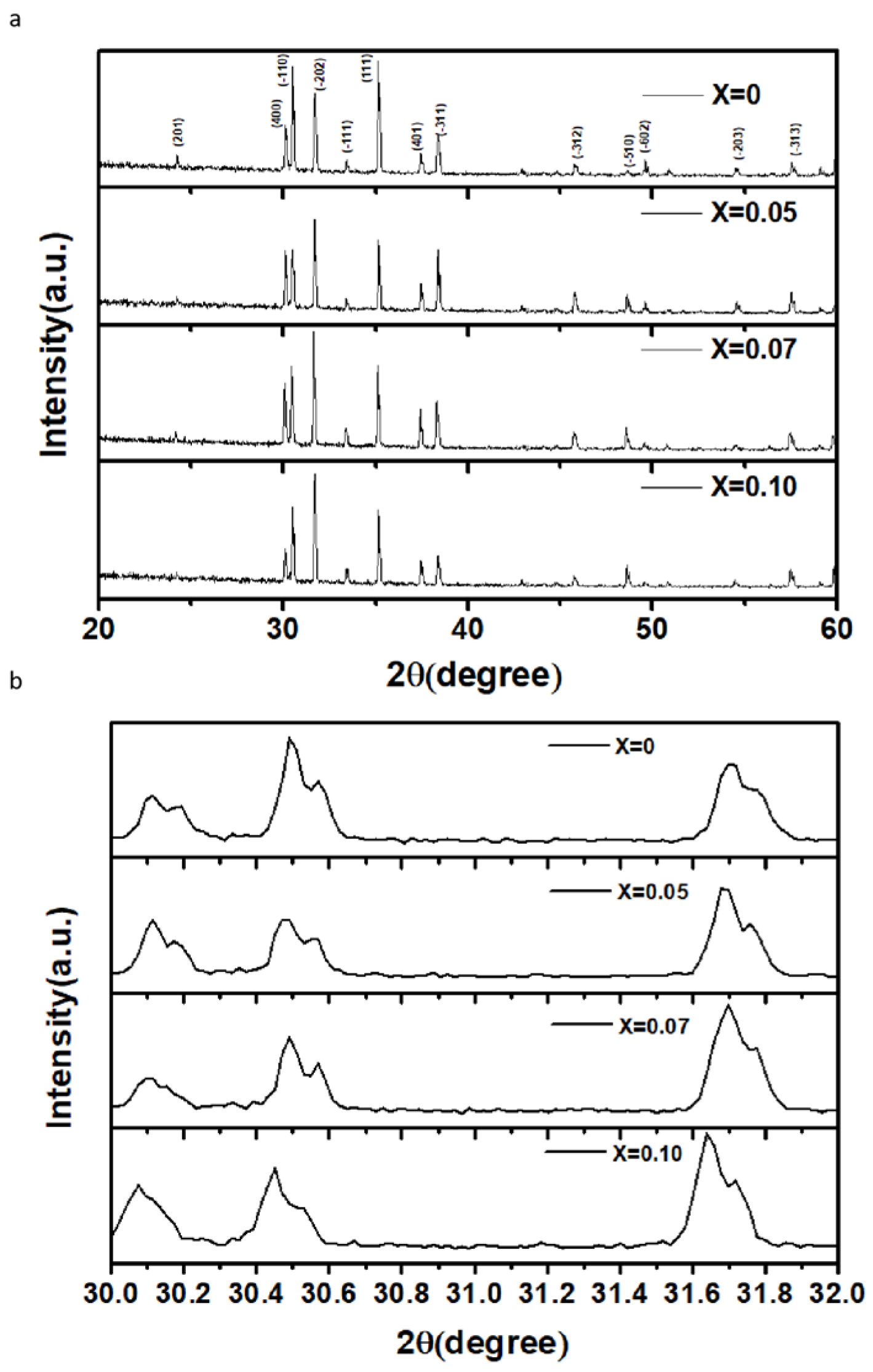
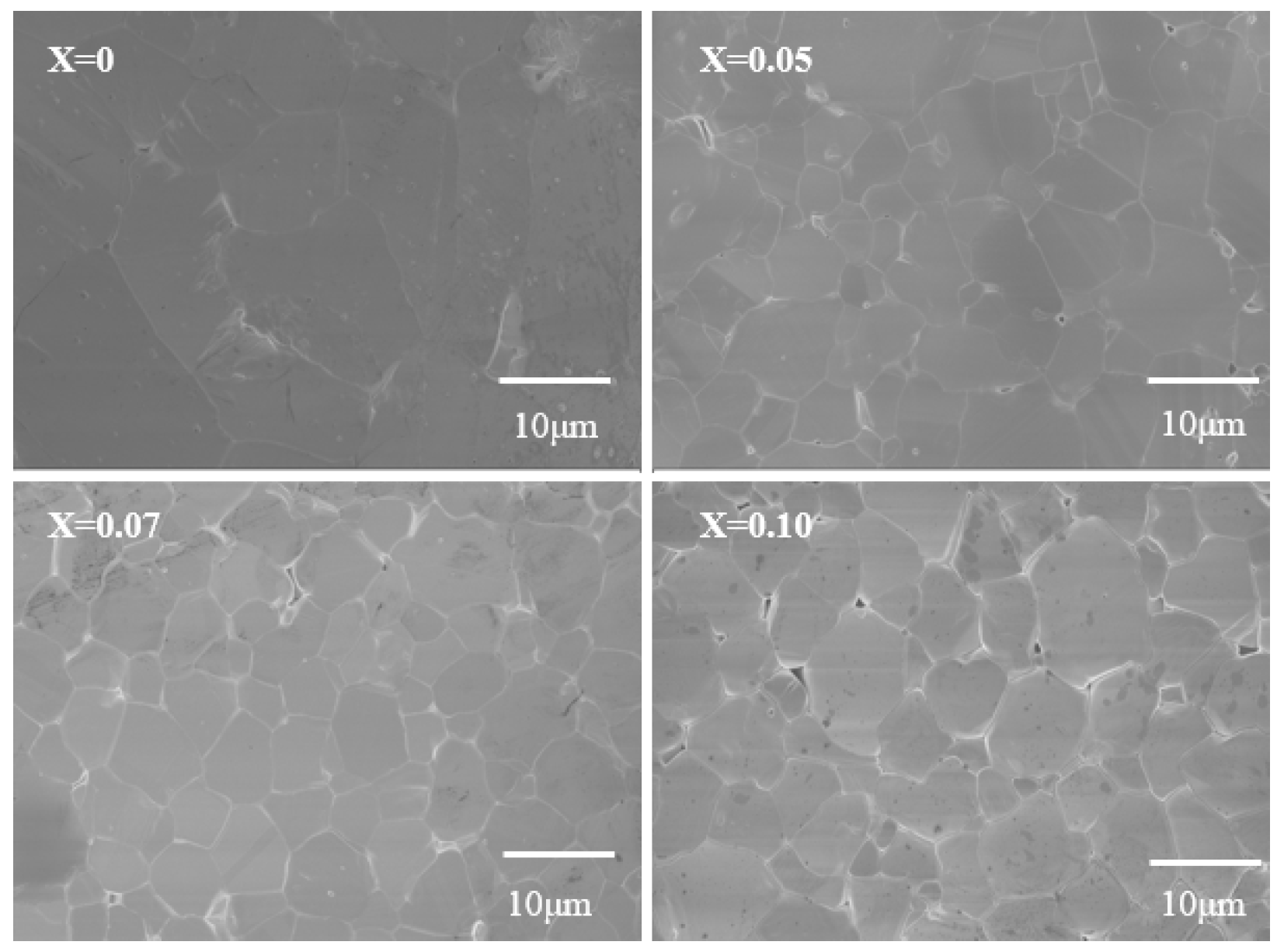
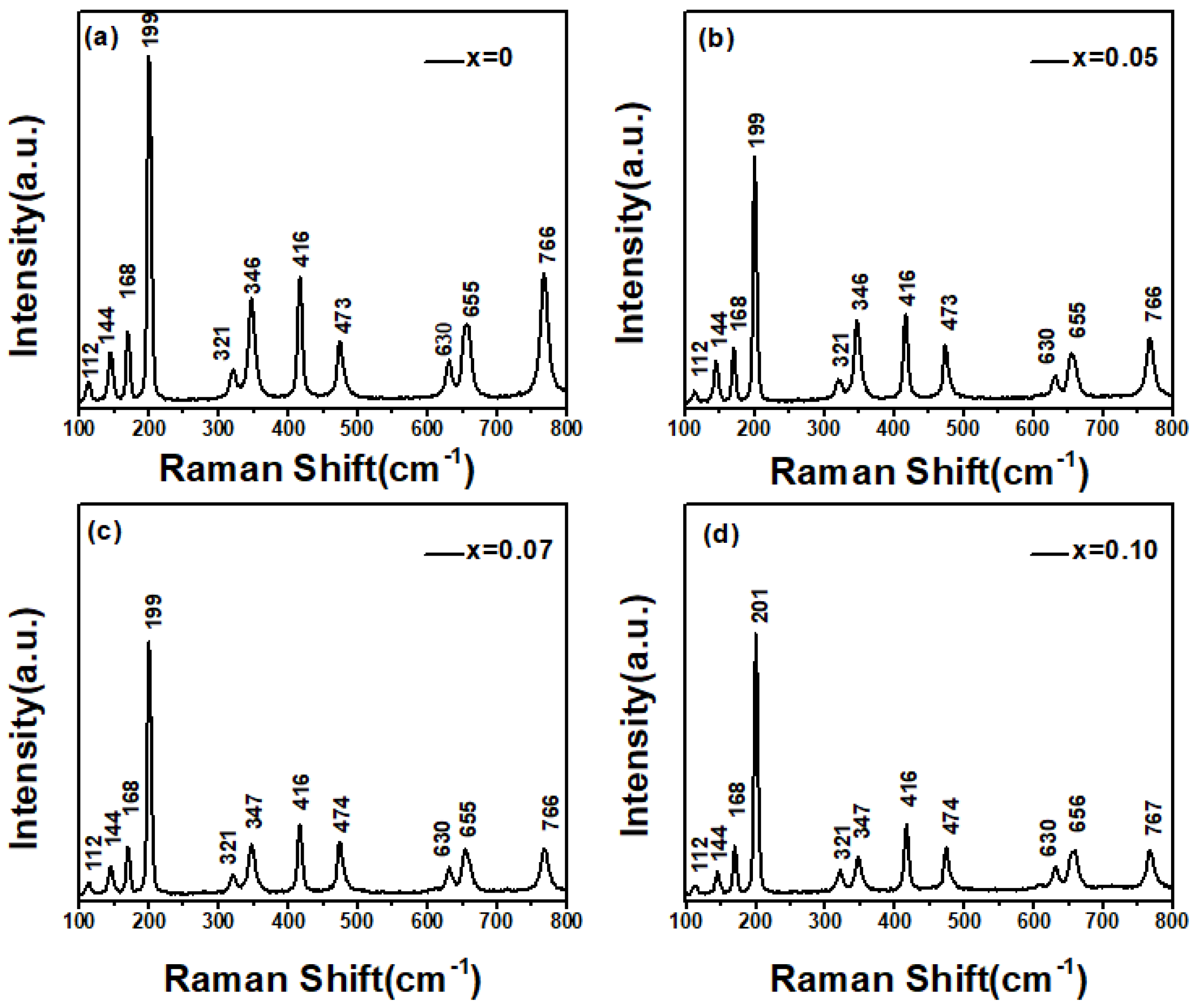
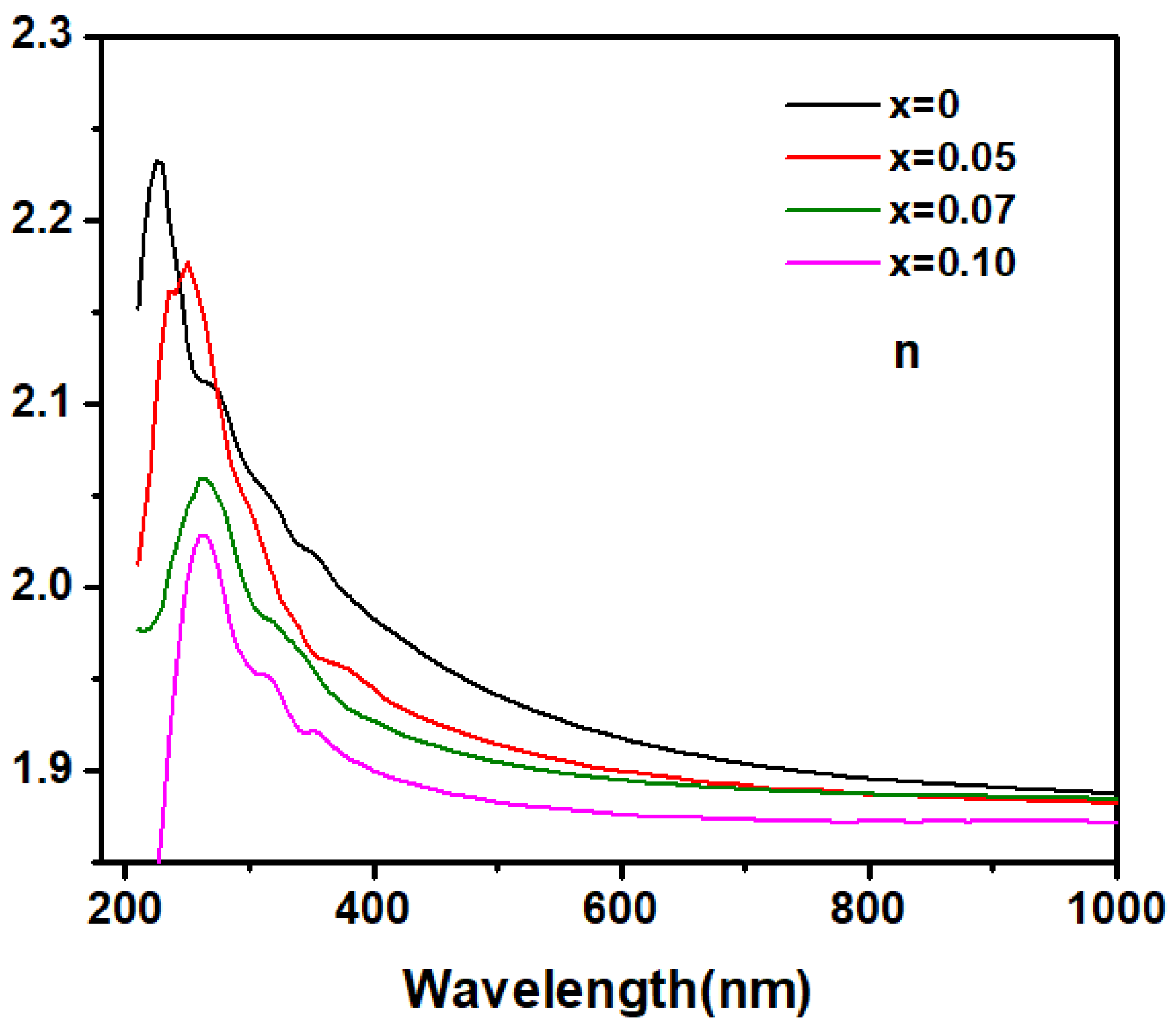
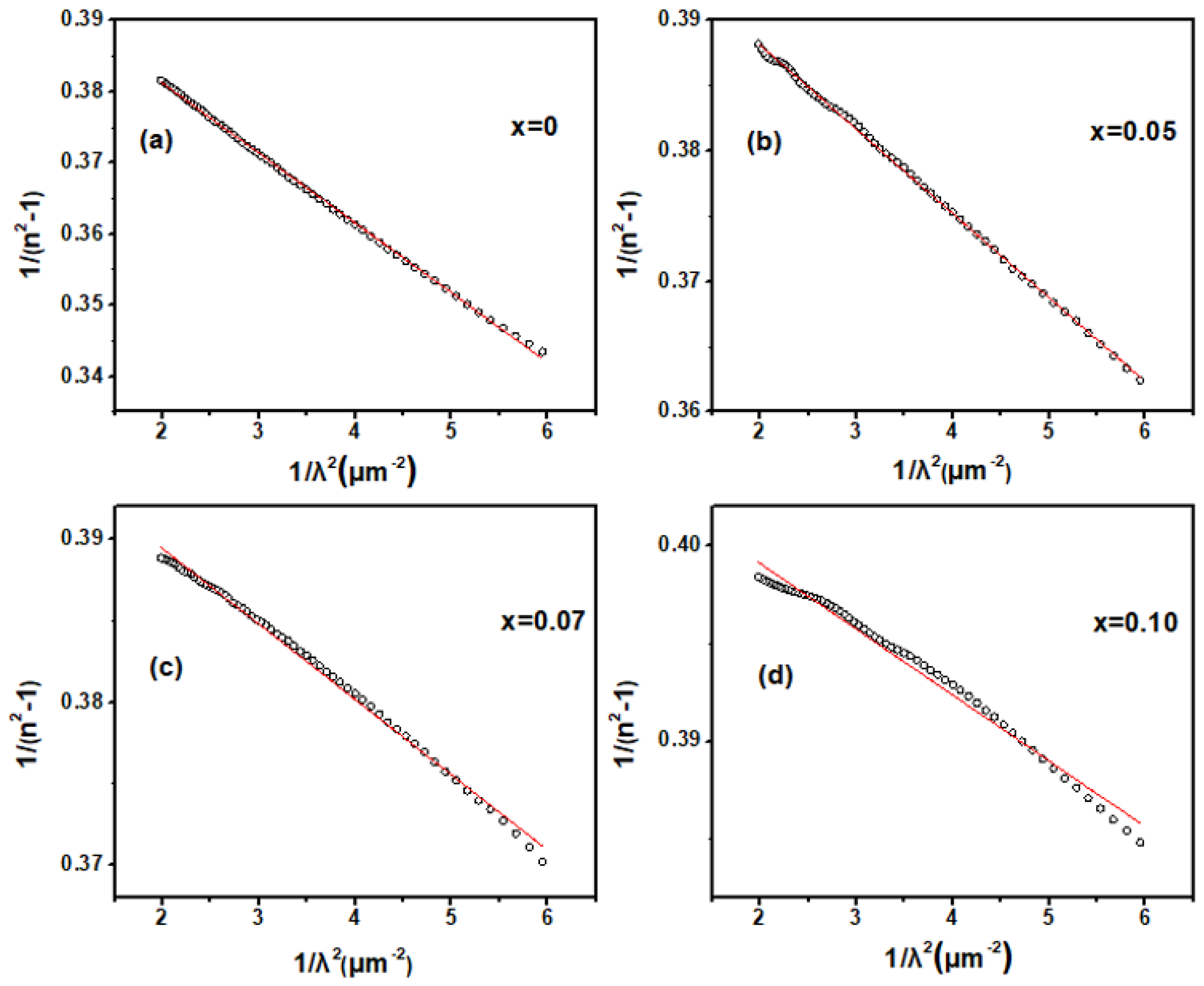

Disclaimer/Publisher’s Note: The statements, opinions and data contained in all publications are solely those of the individual author(s) and contributor(s) and not of MDPI and/or the editor(s). MDPI and/or the editor(s) disclaim responsibility for any injury to people or property resulting from any ideas, methods, instructions or products referred to in the content. |
© 2025 by the authors. Licensee MDPI, Basel, Switzerland. This article is an open access article distributed under the terms and conditions of the Creative Commons Attribution (CC BY) license (https://creativecommons.org/licenses/by/4.0/).
Share and Cite
Yan, Y.; Zhu, S.; Yang, J.; Zhang, Y.; Bai, W.; Tang, X. Effects of Zn Doping on Optical Properties of Polycrystalline β-Ga2O3. Inorganics 2025, 13, 99. https://doi.org/10.3390/inorganics13040099
Yan Y, Zhu S, Yang J, Zhang Y, Bai W, Tang X. Effects of Zn Doping on Optical Properties of Polycrystalline β-Ga2O3. Inorganics. 2025; 13(4):99. https://doi.org/10.3390/inorganics13040099
Chicago/Turabian StyleYan, Yue, Shuai Zhu, Jing Yang, Yuanyuan Zhang, Wei Bai, and Xiaodong Tang. 2025. "Effects of Zn Doping on Optical Properties of Polycrystalline β-Ga2O3" Inorganics 13, no. 4: 99. https://doi.org/10.3390/inorganics13040099
APA StyleYan, Y., Zhu, S., Yang, J., Zhang, Y., Bai, W., & Tang, X. (2025). Effects of Zn Doping on Optical Properties of Polycrystalline β-Ga2O3. Inorganics, 13(4), 99. https://doi.org/10.3390/inorganics13040099





